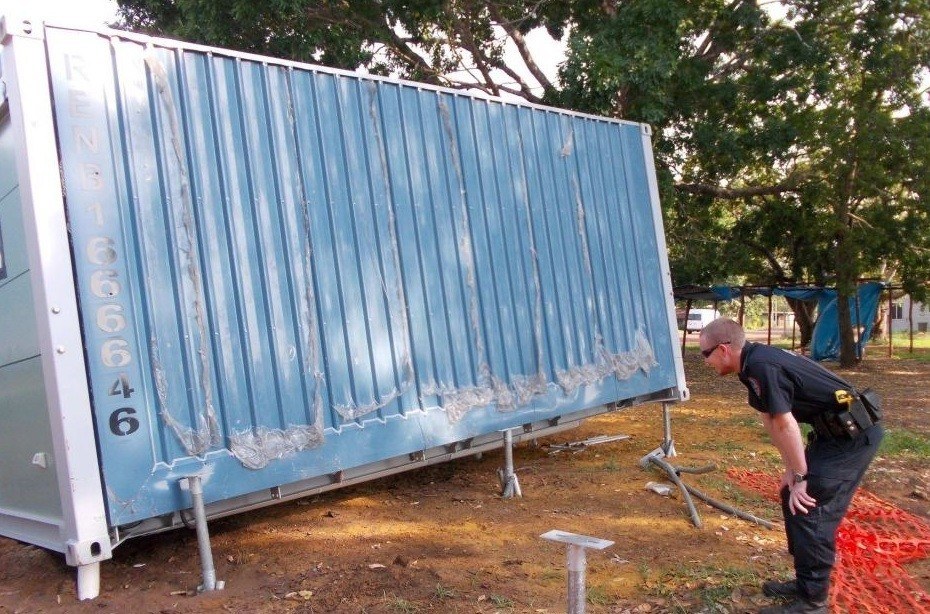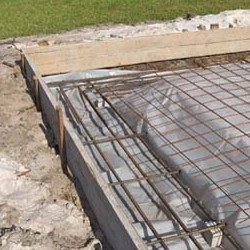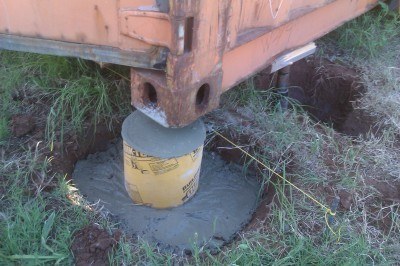
In an earlier post, Top 8 Points to Consider When Buying or Hiring a Shipping Container, we discussed the need for a level foundation to place your shipping container on. Whether you’re hiring a container for a short term storage solution or buying a container as a workshop or shed, it’s important that you plan out your foundation properly. A solid, well prepared foundation will help to keep your shipping container stable and square, and can also help guard against exposure to moisture and the corrosion caused by this. If a shipping container is not kept on a level surface, you may encounter issues when trying to open and close the doors, particularly when the container is full.
The most common types of foundations are:
- Concrete slabs
- Concrete footings
- Wooden beam footings

Concrete Slab Foundations for Shipping Containers
If space, time and budget aren’t an issue for you, then building a concrete slab may be an option. Due to the cost of materials and labour required, this is one of the most expensive methods of creating a solid foundation. The volume of concrete required is substantial and it needs to be poured quickly in order to set properly. Hiring a crew to help would be ideal. If you’re thinking of undertaking any of the building yourself, remember that a slab foundation for a shipping container should be designed differently than a normal slab foundation due in part to where the weight of the container is carried on the edges and corners of the foundation.
Concrete Footings for Shipping Containers
If you’re planning on keeping your container in one place for an extended period of time, but you’re conscious of budget and want to avoid building a slab, then concrete footings might be for you. But don’t be fooled- while they might be a more cost effective option, concrete footings require meticulous planning and attention to detail, so make sure you have plenty of time to invest in getting it right.
 Here are a few things to consider when planning to build concrete footings:
Here are a few things to consider when planning to build concrete footings:
- How deep do the footings need to be? Think about whether the ground is prone to frost.
- How large do the footings need to be?
- How much space will you need? Measure and mark off the area, posting stakes and tying them off for a strong visual indication of the space needed for the container. Shipping container dimensions
- How much time do you have before the container arrives? The footings should be completed several weeks prior to arrival, but it’s recommended that you speak to a professional about this as the time taken for the concrete to cure can vary from area to area depending on variations in heat and humidity.
Wooden Beam Footings
The easiest and most affordable option for a shipping container foundation is using wooden beams. Less material is needed as you only need to build support for the four corners of the container, however supporting the middle points on the long side of the container can provide extra stability. Unlike concrete slabs and footings, wooden beams can be installed much closer to the arrival time of your container and require far less site preparation.
It is recommended that a gravel bed is made under the wooden beams to help with drainage, keeping the beams dry and preventing premature rotting. Air circulation is allowed for by keeping the container at least 15cm (6 inches) off the ground.
Once you’ve gone to the effort to build a solid foundation, make sure you’re putting a top quality shipping container on it. Speak to Premier Box Shipping Containers. They offer immediate delivery in most areas of Australia, and with 20 years combined experience in the shipping container industry, they offer the most cost effective, efficient and dependable shipping container solutions available. Call now on 07 3888 3011 or CLICK to get a shipping container price quote online.



